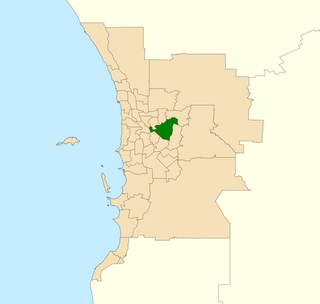The Western Australian Legislative Assembly is elected from 59 single-member electoral districts. These districts are often referred to as electorates or seats.

Albany is a Legislative Assembly electorate in the state of Western Australia. Albany is named for the port and regional city of Western Australia which falls within its borders. It is one of the oldest electorates in Western Australia, with its first member having been elected in the inaugural 1890 elections of the Legislative Assembly. It is regarded as a swinging seat, and has been held by the Labor Party since the 2001 election, at which Peter Watson was first elected. Watson announced his retirement prior to the 2021 election and was succeeded in the seat by Labor Party colleague, Rebecca Stephens.

Riverton is a Legislative Assembly electorate in the state of Western Australia. Riverton is named for the southern Perth suburb of Riverton, which falls within its borders.

Armadale is a Legislative Assembly electorate in the state of Western Australia. The district is named for the southeastern Perth suburb of Armadale, which falls within its borders.

Belmont is an electoral district of the Legislative Assembly in the Australian state of Western Australia. Belmont is named for the inner eastern Perth suburb of Belmont, which falls within its borders.

The electoral district of Pilbara is a Legislative Assembly electorate in the state of Western Australia. Pilbara is named for the region of Western Australia in which it is located. It is one of the oldest electorates in Western Australia, with its first member having been elected to the Second Parliament of the Legislative Assembly at the 1894 elections.

Churchlands is a Legislative Assembly electorate in the state of Western Australia. Churchlands is named for the western suburb of Churchlands, which falls within its borders, and was created at the 1994 redistribution, replacing the seat of Floreat which had existed since 1968.
Mindarie was an electoral district of the Legislative Assembly in the Australian state of Western Australia. The district was named for the outer northern Perth suburb of Mindarie, which falls within its borders.

The electoral district of Perth is a Legislative Assembly electorate in the state of Western Australia. Perth is named for the capital city of Western Australia whose central business district falls within its borders. It is one of the oldest electorates in Western Australia, with its first member having been elected in the inaugural 1890 elections of the Legislative Assembly.
Murdoch was an electoral district of the Legislative Assembly in the Australian state of Western Australia. It existed from 1977 to 1989 and again from 1996 to 2008.

Dawesville is a Legislative Assembly electorate in the state of Western Australia. Dawesville is named for the southwestern Mandurah suburb of Dawesville, which falls within its borders.

The Agricultural Region is a multi-member electoral region of the Western Australian Legislative Council, located in the South West, Peel and part of the Great Southern regions of the state. It was created by the Acts Amendment Act 1987, and became effective on 22 May 1989 with five members who had been elected at the 1989 state election three months earlier. At the 2008 election, it was increased to six members.

The Mining and Pastoral Region is a multi-member electoral region of the Western Australian Legislative Council, located in the northern and eastern regions of the state. It was created by the Acts Amendment Act 1987, and became effective on 22 May 1989 with five members who had been elected at the 1989 state election three months earlier. At the 2008 election, it was increased to six members.

The North Metropolitan Region is a multi-member electoral region of the Western Australian Legislative Council, located in the north-western and western suburbs of Perth. It was created by the Acts Amendment Act 1987, and became effective on 22 May 1989 with seven members who had been elected at the 1989 state election three months earlier. At the 2008 election, it was decreased to six members.

The South Metropolitan Region is a multi-member electoral region of the Western Australian Legislative Council, located in the southern suburbs of Perth, Western Australia. It was created by the Acts Amendment Act 1987, and became effective on 22 May 1989 with five members who had been elected at the 1989 state election three months earlier. At the 2008 election, it was increased to six members.

The South West Region is a multi-member electoral region of the Western Australian Legislative Council the South West, Peel and part of the Great Southern regions of the state. It was created by the Acts Amendment Act 1987, and became effective on 22 May 1989 with seven members who had been elected at the 1989 state election three months earlier. At the 2008 election, it was reduced to six members. The region includes the cities of Albany, Bunbury and Mandurah.

Mount Lawley is an electorate in the state of Western Australia. Mount Lawley is named for the inner north-eastern Perth suburb of Mount Lawley, which falls within its borders.

Jandakot is an electoral district of the Legislative Assembly in the Australian state of Western Australia.

Scarborough is an electoral district of the Legislative Assembly in the Australian state of Western Australia.

Kalamunda is an electoral district of the Legislative Assembly in the Australian state of Western Australia.

















